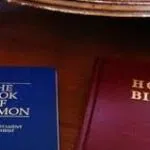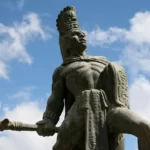One of the most common arguments against the authenticity of the Book of Mormon is the claim that many of its place names resemble those found in the region where Joseph Smith lived. Critics argue that this similarity suggests Joseph Smith simply fabricated the Book of Mormon using names from his local environment. At first glance, this argument might seem convincing, especially to those unfamiliar with the complexities of the issue. But when you take a closer look, the logic behind this claim quickly falls apart. Let’s explore why this argument doesn’t hold up under scrutiny and why the Book of Mormon deserves to be evaluated on a much deeper level.
Coincidences in Naming: A Universal Phenomenon
First, let’s consider something fundamental, names repeat. This is a universal phenomenon, not some grand conspiracy. Settlers and explorers have always had a habit of reusing names from one place when naming new locations. This is true throughout history, and the United States is a perfect example. How many places in the U.S. are named after biblical or European locations? Just think about it: Bethlehem, Jordan, Rome, Paris, Athens, and Troy are all place names found in America. Does that mean America is just a copy of ancient Israel or Greece? Of course not.
By this same logic, even if some Book of Mormon names resemble 19th-century American place names, that does not automatically mean Joseph Smith borrowed them. Many of the names critics point to are not even exact matches but are only somewhat similar phonetically. If Joseph Smith had been fabricating the book, wouldn’t it have made more sense for him to use direct replications instead of altered versions of place names?
Selective Sampling and Confirmation Bias
Another major flaw in this argument is the selective nature of the evidence presented. Critics cherry-pick names that sound similar while ignoring the vast majority of Book of Mormon names that have no equivalent in early American geography.
For example, where are the counterparts for names like Zarahemla, Ammonihah, Nephi, and Bountiful in Joseph Smith’s surroundings? These names have no known correlation to 19th-century place names, yet they make up a significant portion of the Book of Mormon narrative. If Joseph Smith had simply borrowed from his environment, why wouldn’t we see a much higher percentage of recognizable names?
This is a textbook example of confirmation bias, looking only for evidence that supports a pre-existing conclusion while ignoring anything that contradicts it. The truth is, if we dig deep enough, we can find coincidental name similarities between almost any two geographic areas in the world.
The Problem with the Map Approach
Let’s take a moment to talk about the maps that critics often reference when making these claims. The argument suggests that Joseph Smith looked at a map of his surrounding area and lifted names from various places to create his story. But if you actually examine these maps, a glaring issue arises—the names aren’t clustered together in one small region. Instead, they are scattered across vast distances, sometimes even spanning different states.
If Joseph Smith had intended to copy names directly from his environment, wouldn’t it have been more logical for him to keep the locations consistent and geographically sensible? Instead, the so-called matches appear randomly distributed, weakening the argument that he was simply replicating local geography.
Additionally, many of the place names are obscure towns or geographical features that an average person in Joseph Smith’s time would likely never have heard of. If he was fabricating the Book of Mormon based on local geography, why would he pick such minor locations rather than well-known towns and cities?
Ancient Linguistic Parallels
Now, let’s get into something even more fascinating, linguistics. One of the strongest pieces of evidence against the idea that Joseph Smith simply made up names is the presence of legitimate linguistic patterns in the Book of Mormon. Many Book of Mormon names have plausible connections to ancient Semitic and Mesoamerican languages. Now, unless Joseph Smith had a secret stash of ancient linguistic texts (which, let’s be real, he didn’t), this presents a major challenge to the claim that he fabricated the book.
For instance, the names “Nephi” and “Lehi” closely align with Hebrew and Egyptian linguistic roots. “Zarahemla” bears strong similarities to ancient Near Eastern naming conventions. Modern linguistic research has found additional connections between Book of Mormon names and Semitic, Egyptian, and Mayan languages—languages Joseph Smith would have had no knowledge of.
If he was just pulling names from his environment, why do we find these deep linguistic ties to ancient cultures? The presence of these sophisticated naming patterns suggests that the names in the Book of Mormon weren’t arbitrarily chosen or copied from a map, but rather, they belong to an intricate and ancient linguistic system.
A Personal Experience with Linguistic Coincidences
During my time living in Guatemala, I had many fascinating discussions with missionaries about the Book of Mormon and its possible connections to ancient cultures. One of the most memorable experiences involved missionaries who excitedly pointed out what they believed was evidence of Hebrew influence in the K’iche’ Mayan language. They noted that in K’iche’, the pronoun “at” was used as a second-person singular pronoun, and in Hebrew, “at” is also a second-person singular pronoun—though specifically feminine.
The missionaries saw this as proof that the Book of Mormon’s account of a Hebrew-influenced civilization in the Americas was accurate. While their enthusiasm was admirable, I had to gently explain to them that this was simply a phonetic coincidence, nothing more. Just because two languages share a similar-sounding word with a similar meaning does not imply a direct linguistic connection. This kind of accidental overlap happens frequently in languages around the world. The excitement over such findings is understandable, but linguistic evidence needs to be approached with scholarly rigor rather than assumptions based on surface similarities.
This experience reinforced for me the importance of careful linguistic analysis rather than jumping to conclusions based on coincidental phonetics. The same principle applies to claims that Book of Mormon names are copied from modern maps—similar-sounding names do not automatically indicate derivation.
The Internal Consistency of Book of Mormon Geography
One of the most remarkable aspects of the Book of Mormon is its internal consistency when it comes to geography. If Joseph Smith had borrowed names from his environment without much thought, we would expect to see a disjointed, haphazard geographical narrative. Instead, we find a highly detailed and internally consistent description of lands, cities, and geographical markers that fit together in a sophisticated way.
Scholars who have studied the internal geography of the Book of Mormon have been able to map out relationships between cities, distances, and travel times. These relationships demonstrate a level of complexity that would be difficult for an uneducated 19th-century farm boy to create out of thin air.
Even more fascinating, the descriptions of climate, trade routes, and topography in the Book of Mormon suggest a setting that aligns more closely with ancient Mesoamerica than with upstate New York. If Joseph Smith had copied from his environment, why would he describe a climate and geography that doesn’t match his own surroundings?
The Book of Mormon Deserves Serious Consideration
At the end of the day, the claim that Joseph Smith simply copied local names and geography to create the Book of Mormon is weak at best. It relies on cherry-picked evidence, ignores linguistic and geographical complexities, and ultimately fails to account for the depth and sophistication of the text.
The Book of Mormon continues to inspire and transform lives, not because of alleged name similarities, but because of its deep spiritual message and profound teachings. For those willing to look beyond surface-level arguments, the evidence suggests that the Book of Mormon is far more than a mere product of its time—it is a powerful and inspired work worthy of serious study and consideration.





